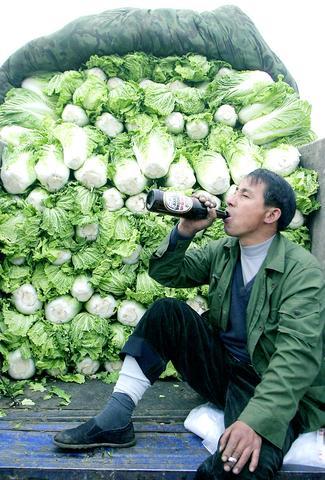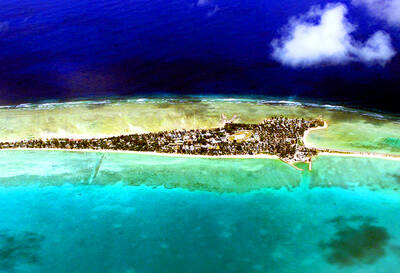To the Chinese capital, the dawn of November long meant one thing -- the invasion of winter cabbage, the government-subsidized, not-too-tasty "patriotic vegetable" that sustained the masses through the icy months.
Rickety trucks from one-horse towns streamed into the city, laden with heads of da baicai -- big cabbage. Folks queued their donkey carts and wheelbarrows, anxiously stocking up. Refrigeratorless families by the millions lined gray rooftops with edible green shingles.

PHOTO: AP
This week, the cabbages are coming, right on schedule. But it's not like it used to be.
With each November's passing, the fuel of the proletarian revolution is becoming simply another lifestyle choice in a shiny city of dizzying selections. And therein lies a tale -- of economic progress, increasing affluence, and a generation of palates weaned on Pizza Hut.
"Old grandpas still fondly remember da baicai. But for people my age, it's just like any other vegetable," said Dong Yue, 34. He oversees marketing for Dayanglu, one of Beijing's largest wholesale produce markets. Its inventory this week includes 109 varieties of vegetables.
In recent days, vendors from all corners of the land have brought their perishable harvests to Dayanglu for the pre-winter rush. Color is splashed everywhere: scarlet bell peppers, emerald hot peppers, eggplants in deep purple.
Armed with the inventory of available vegetables, Dong ticks off those that many farmers hadn't heard of a decade ago. When he's done, 50 of the 109 items are checked -- everything from iceberg lettuce to celery to the more exotic "monkey-head mushrooms."
"Lines for da baicai? You won't see that anymore," said Gao Zhanmin, laughing as his half-full truck of cabbages loomed behind him. "They want one bunch, they just go out and buy it. They don't need to fill their homes with it anymore."
Twenty years ago, 95 percent of sales at Beijing's wholesale produce markets came from da baicai. Ten years ago, it was between 50 and 70 percent. This year, Dong expects just 9 percent of Dayanglu's sales to come from the cabbage.
On Monday, the government's Xinhua News Agency said demand for da baicai -- known to most Americans as Napa cabbage or by its Cantonese name, bok choy -- was expected to plummet yet again, this time by 8.3 percent from last year.
"The house vegetable of Beijing has lost its vaunted position," Xinhua said with a whiff of lament.
It's hardly disappearing: In 2001, the average Beijing resident consumed 35kg of the cabbage. But China's two-decade experiment in capitalism has brought extraordinary changes to everyday life, and even to cabbage.
When economic reform began in the late 1970s, Beijing was emerging from Mao Zedong's (毛澤東) Cultural Revolution. Restaurants, scorned for years as bourgeois, were rare. Among winter's few certainties were the odor of burning coal, the wizened men on street corners selling sunflower seeds from burlap sacks, and the cabbage.
Da baicai became Beijing's culinary canvas. There was cabbage in sour sauce. Cabbage soup. Cabbage and bean curd. Braised cabbage over rice. And on special days, cabbage dumplings -- sometimes with a bit of minced pork.
"There were no other vegetables. And no one could have afforded them anyway," said Ma Laicang, owner of the Old Beijing Zhajiang Noodle King, a restaurant offering several cabbage dishes.
A 1988 shortage caused panic buying, and a glut the following year left 80,000 tonnes of cabbage piled in the streets. The mayor invoked patriotism and ordered public offices, schools, factories and army units to stock up. The cabbage crisis ebbed.
In 1992, the government cut its cabbage subsidy. Five years later, it deregulated the price. Popularity plummeted. Why hoard cabbage when so many other delicacies were available?
In today's Beijing, the French superstore Carrefour sells fresh-squeezed grapefruit juice, nine varieties of mushrooms and an entire aisle of canned vegetables -- a sharp contrast to Beijing of 1980, when an average Chinese couldn't buy a Coca-Cola without knowing a foreigner.

DISASTER: The Bangladesh Meteorological Department recorded a magnitude 5.7 and tremors reached as far as Kolkata, India, more than 300km away from the epicenter A powerful earthquake struck Bangladesh yesterday outside the crowded capital, Dhaka, killing at least five people and injuring about a hundred, the government said. The magnitude 5.5 quake struck at 10:38am near Narsingdi, Bangladesh, about 33km from Dhaka, the US Geological Survey (USGS) said. The earthquake sparked fear and chaos with many in the Muslim-majority nation of 170 million people at home on their day off. AFP reporters in Dhaka said they saw people weeping in the streets while others appeared shocked. Bangladesh Interim Leader Muhammad Yunus expressed his “deep shock and sorrow over the news of casualties in various districts.” At least five people,

ON THE LAM: The Brazilian Supreme Court said that the former president tried to burn his ankle monitor off as part of an attempt to orchestrate his escape from Brazil Former Brazilian president Jair Bolsonaro — under house arrest while he appeals a conviction for a foiled coup attempt — was taken into custody on Saturday after the Brazilian Supreme Court deemed him a high flight risk. The court said the far-right firebrand — who was sentenced to 27 years in prison over a scheme to stop Brazilian President Luiz Inacio Lula da Silva from taking office after the 2022 elections — had attempted to disable his ankle monitor to flee. Supreme Court judge Alexandre de Moraes said Bolsonaro’s detention was a preventive measure as final appeals play out. In a video made

It is one of the world’s most famous unsolved codes whose answer could sell for a fortune — but two US friends say they have already found the secret hidden by Kryptos. The S-shaped copper sculpture has baffled cryptography enthusiasts since its 1990 installation on the grounds of the CIA headquarters in Virginia, with three of its four messages deciphered so far. Yet K4, the final passage, has kept codebreakers scratching their heads. Sculptor Jim Sanborn, 80, has been so overwhelmed by guesses that he started charging US$50 for each response. Sanborn in August announced he would auction the 97-character solution to K4

SHOW OF FORCE: The US has held nine multilateral drills near Guam in the past four months, which Australia said was important to deter coercion in the region Five Chinese research vessels, including ships used for space and missile tracking and underwater mapping, were active in the northwest Pacific last month, as the US stepped up military exercises, data compiled by a Guam-based group shows. Rapid militarization in the northern Pacific gets insufficient attention, the Pacific Center for Island Security said, adding that it makes island populations a potential target in any great-power conflict. “If you look at the number of US and bilateral and multilateral exercises, there is a lot of activity,” Leland Bettis, the director of the group that seeks to flag regional security risks, said in an